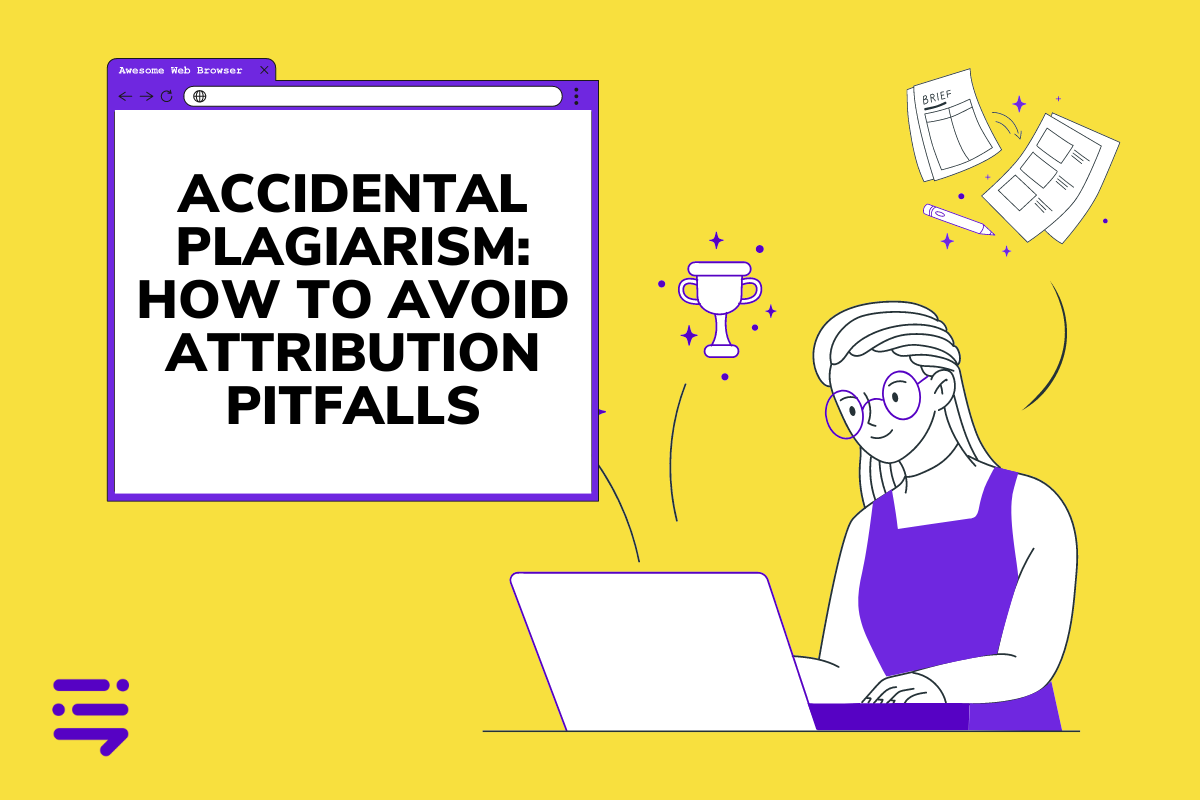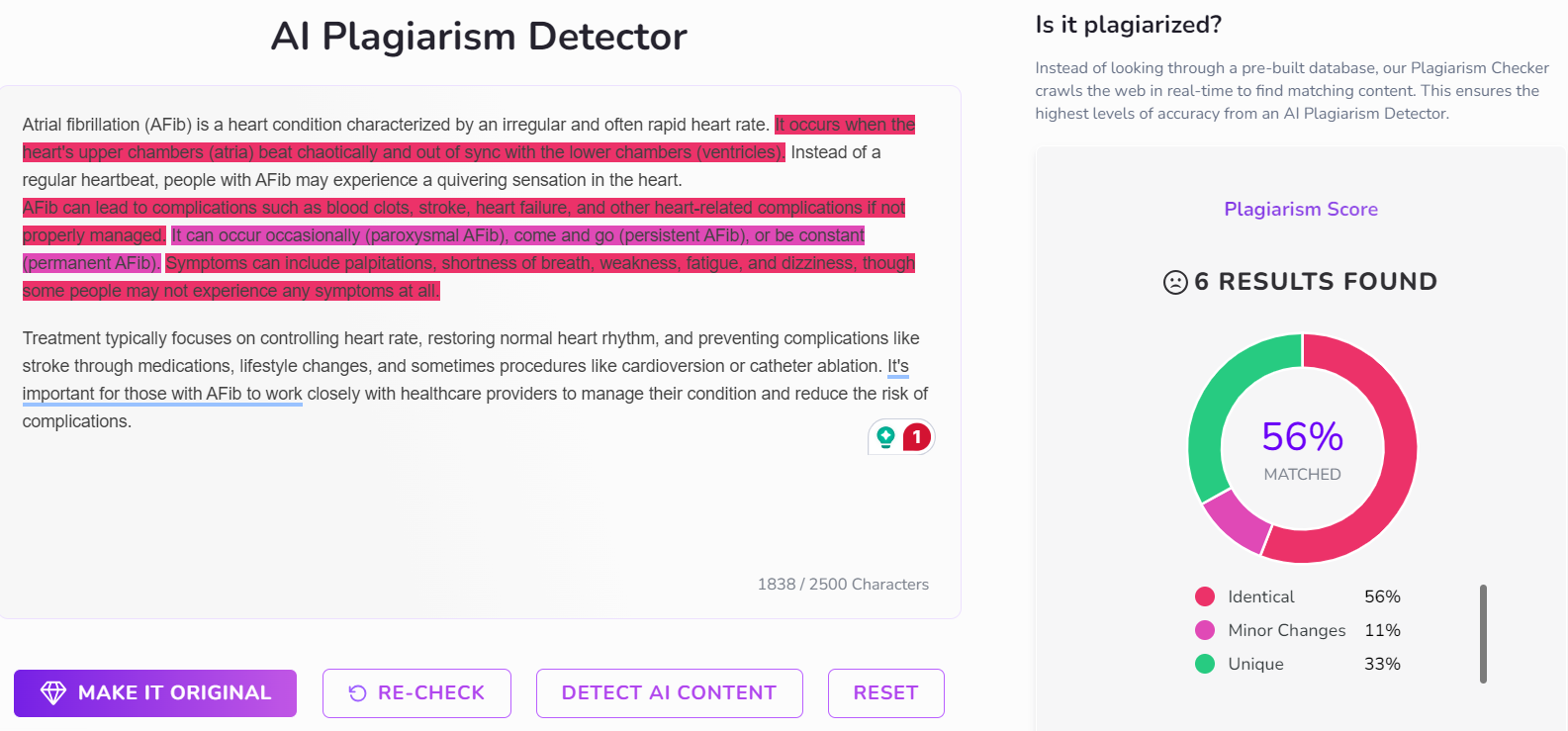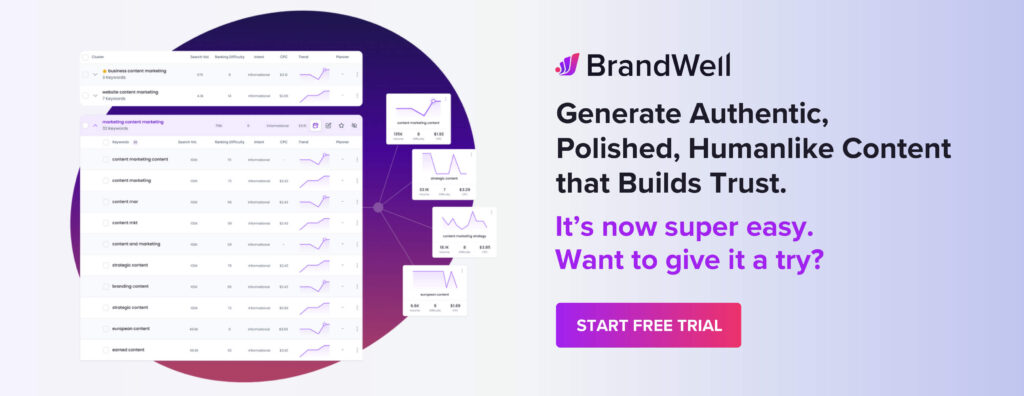Discover top guides, trends, tips and expertise from AIO Writers
Accidental Plagiarism: How to Avoid Attribution Pitfalls
Julia McCoy
Wednesday, 19th Jun 2024
Have you ever accidentally worn mismatched socks? It’s a simple mistake, right? But accidental plagiarism, although unintentional, can have pretty big consequences in the academic and professional world.
Whether you forget to cite a source properly, rely a little too much on someone else’s wording, or misunderstand common knowledge, these instances may lead to accidental plagiarism.
Let’s discuss what is accidental plagiarism and how to avoid it.
Table Of Contents:
- What is Accidental Plagiarism?
- Why is Accidental Plagiarism Still a Big Deal?
- How to Avoid Accidental Plagiarism
- How Educational Institutions Can Help Prevent Unintentional Plagiarism
- The Long and Short of Accidental Plagiarism
- FAQs: Accidental Plagiarism
- Conclusion
What is Accidental Plagiarism?
We’ve all been there – up late, scrambling to finish a paper, the pressure mounting. You find a great source and, in your haste, forget to put a quote in quotation marks, or perhaps paraphrase a bit too closely to the original text.
You haven’t intentionally set out to steal someone else’s work; you’ve simply made a mistake.
This is the essence of accidental plagiarism.
So what constitutes accidental plagiarism?
According to Bowdoin College’s Office of the Dean of Students:
“Accidental plagiarism occurs when a person forgets or neglects to cite their sources, misquotes their sources, or unintentionally paraphrases a source by using similar words, groups of words, and/or sentence structure without attribution.”
Even though it’s unintentional, accidental plagiarism can have serious consequences, just like intentional plagiarism.
For instance, submitting a paper with sections copied verbatim from various online articles, even without intending to cheat, can lead to academic penalties.
Similarly, professional writers should know that forgetting to attribute an idea found online or paraphrasing content without proper citation can harm their reputation.
Types of Accidental Plagiarism
Accidental plagiarism can occur due to a variety of reasons:
- Inadequate Paraphrasing: You’ve changed a few words here and there, but the sentence structure mirrors the original text too closely.
- Misplaced or Missing Quotation Marks: Directly lifting text without indicating that it’s a direct quote, even if you cite the source, is a big no-no.
- Inconsistent Citations: Using different citation formats or simply forgetting to cite a source can lead to a confusing and potentially problematic paper.
Remember, different institutions and publications have their own preferred citation styles, and accidental plagiarism can arise from a misunderstanding of these styles.
Why is Accidental Plagiarism Still a Big Deal?
Let’s face it – the line between intentional and accidental plagiarism can be blurry.
However, when it comes to consequences, that line tends to vanish.
Why?
Because, unfortunately, it’s incredibly difficult to prove whether someone knowingly or unknowingly plagiarized.
Whether accidental or intentional, plagiarism damages the integrity of the work and can erode trust in the author.
Academic institutions have strict rules regarding plagiarism, and the penalties can be severe. They range from a failing grade to even expulsion, regardless of intent.
You wouldn’t want to jeopardize your academic career because of an honest mistake.
On the other hand, imagine a researcher publishing groundbreaking work only to have their reputation tarnished by allegations of accidental plagiarism.
A 2019 survey by Vassileva and Chankova found that while a surprising number of researchers (44%) didn’t view unintentional plagiarism as a “crime”, it objectively holds the same consequences.
Its impact on the author’s reputation, research funding opportunities, and the journal’s credibility remain detrimental, mirroring the effects of intentional plagiarism.
Real-World Repercussions
Here are some real-world examples of accidental plagiarism and its consequences:
In 2022, Terry Magnuson, a prominent researcher and university leader, found himself in hot water due to accidental plagiarism. He was accused of plagiarizing content, later admitting to his mistake in a startlingly candid open letter to his colleagues.
During the 2016 Republican National Convention, Melania Trump delivered a speech that included several lines that were strikingly similar to Michelle Obama’s 2008 Democratic National Convention speech. The Trump campaign acknowledged that passages were inadvertently included by a speechwriter who had taken notes from Obama’s speech without realizing it.
In 2013, renowned primatologist Jane Goodall faced accusations of plagiarism in her book “Seeds of Hope.” Several passages were found to be copied from websites like Wikipedia and other sources without proper attribution. Goodall and her co-author explained that the errors were unintentional, resulting from insufficient fact-checking and citation during the editing process.
In 2012, journalist and author Fareed Zakaria was suspended by Time magazine and CNN after it was discovered that parts of his column on gun control were similar to an article published by Jill Lepore in The New Yorker. Zakaria apologized, stating that he had made a “terrible mistake” and that it was an unintended oversight.
In 1978, author Alex Haley was sued by Harold Courlander, who claimed that Haley had copied portions of his novel “The African” for his book “Roots.” Haley admitted that he had unintentionally included some passages from Courlander’s work and settled the lawsuit out of court for $650,000.
These cases underscore that accidental plagiarism can happen to anyone – seasoned professionals included. It highlights the critical need for careful writing practices, regardless of experience.
If accidental plagiarism can trip up someone at the top of their field, imagine the risks for those new to academic or professional writing. So remember, no one is immune, and prevention is key.
How to Avoid Accidental Plagiarism
While we often focus on intentional plagiarism, it’s crucial to acknowledge the challenges and complexities that lead to accidental plagiarism, especially in today’s digital landscape where information overload is a real struggle.
Here are a few tips for avoiding accidental plagiarism:
Hone Those Note-Taking Skills
In our fast-paced digital world, copying and pasting snippets of information has become second nature. However, this can be a recipe for accidental plagiarism.
Make sure your notes are detailed and clear. If you do copy text, make it a habit to enclose it within quotation marks and meticulously note down the source’s details there and then.
Learn How to Paraphrase Properly
Paraphrasing isn’t about replacing a few words with synonyms; it’s about genuinely understanding the original material and expressing it in your own words.
Paraphrasing tools can sometimes lead to accidental plagiarism, as pointed out by Jonathan Bailey, who said “the way you avoid plagiarism isn’t to change the language but to never have that language in your original work in the first place.”
Check out this step-by-step guide on how to paraphrase properly to avoid plagiarism.
Master the Citation Game
Citing sources can feel tedious, I get it.
However, failing to do it correctly is a surefire path to unintentional plagiarism.
Familiarize yourself with various citation styles – MLA, APA, Chicago – and learn how to cite sources consistently.
Employing a citation management tool such as RefWorks can streamline the process and make it easier to track sources as you incorporate in-text citations or footnotes.
It might seem like a minor detail but it can be your saving grace in a world where accidental plagiarism is a constant threat.
Citing correctly shows that you’re not trying to pass off someone else’s ideas as your own.
Tap into Technology … Wisely
Luckily, technology can be your ally in the fight against accidental plagiarism. Using plagiarism checkers, such as the one offered by BrandWell, can identify similarities between your writing and existing sources, allowing you to make necessary revisions.
Similar to other plagiarism tools, BrandWell has a text field where you paste your content or upload a file for scanning. But what makes the BrandWell Plagiarism Detector different is its detailed report: it will actually tell you which parts of your text match existing sources, which are slightly plagiarized, and which are completely original.
Here’s what the report looks like:

If you always seem to get very high scores and need to rewrite lots of text, click on the “Make It Original” button to subscribe to the premium version of the tool and the AI will rewrite those plagiarized sections for you.
How Educational Institutions Can Help Prevent Unintentional Plagiarism
Preventing accidental plagiarism is not just the responsibility of individual writers. It requires a combined effort.
Institutions play a vital role in shaping a culture of academic honesty. It’s about equipping students and researchers with the right tools and fostering a deeper understanding of academic integrity, rather than just policing their every move.
Run Awareness Campaigns
Institutions should create engaging awareness campaigns across various platforms, including websites, social media, email, and physical displays.
Think eye-catching infographics about plagiarism, student testimonials, and even interactive workshops on ethical writing.
The Power of Peer Review
Jens Lykkesfeldt emphasizes in his 2016 paper that “a rigorous editorial process, including unbiased peer review and experienced senior editors, remains the most important quality assurance in science.”
Integrating peer review at all academic levels provides valuable feedback. It gives students the chance to critically evaluate their work and ensures they are on the right track with citation and paraphrasing.
The Long and Short of Accidental Plagiarism
Let’s be real – writing, especially in an academic or professional setting, is demanding. It often involves juggling research, analysis, and creativity under strict deadlines.
In this environment, it’s no surprise that accidental plagiarism happens.
Even if you think a particular idea is “common knowledge,” it’s crucial to err on the side of caution and include a citation.
After all, it’s always better to over-cite than under-cite.
Remember, citing sources correctly strengthens your work by demonstrating a thorough and credible approach.
FAQs: Accidental Plagiarism
Is accidental plagiarism okay?
No, accidental plagiarism is not okay. While it may be unintentional, it still violates academic and ethical standards by failing to properly attribute sources or credit original authors.
What is unintentional plagiarism?
Unintentional plagiarism occurs when a person inadvertently uses someone else’s words, ideas, or work without proper citation or attribution. It can happen due to oversight, lack of understanding of citation rules, or failure to distinguish between original and borrowed content.
What is the difference between deliberate plagiarism and accidental plagiarism?
Deliberate plagiarism involves intentionally copying someone else’s work or ideas without attribution, aiming to pass them off as one’s own. In contrast, accidental plagiarism occurs unintentionally due to improper citation or insufficient paraphrasing, where the original source is not properly acknowledged despite no intent to deceive.
Is accidental plagiarism punishable?
Yes, accidental plagiarism can be punishable depending on the context and severity. Educational institutions and professional settings often have policies that require proper attribution of sources, and unintentional failure to do so may result in penalties ranging from warnings to academic sanctions or termination of employment. It’s crucial to understand and adhere to citation standards to avoid the consequences of plagiarism.
Conclusion
Remember: academic integrity applies even when plagiarism isn’t deliberate.
While plagiarism checkers offer valuable support, nothing can replace a genuine understanding of proper citation practices, mindful paraphrasing, and organized note-taking.
By attributing sources, writers can uphold integrity in their work and contribute to a culture of academic honesty and respect for intellectual property.

UNLOCK YOUR POTENTIAL
Long Headline that highlights Value Proposition of Lead Magnet
Grab a front row seat to our video masterclasses, interviews, case studies, tutorials, and guides.



